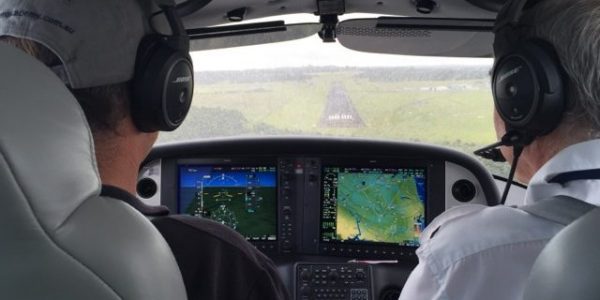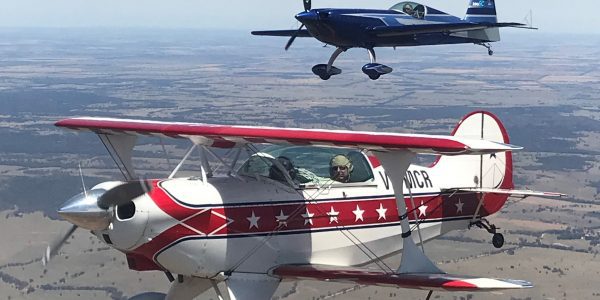NVFR RATING COURSE
NVFR Rating Course
 Expand your horizons and learn to fly in the night sky!
Expand your horizons and learn to fly in the night sky!
Learning to fly at night is an important skill for any prospective Commercial pilot. It’s also useful for Private pilots who don’t want to be unnecessarily constrained by daylight hours!
The AAA NVFR course is a comprehensive course which contains:
- Instrument flight consolidation (full- and limited-panel)
- Night take-offs and landings
- Night visual navigation including supplemental radio navigation aids and GPS use
The instrument flight hours gained on the course can be counted toward the minimum of 10 required for the issue of a Commercial Pilot Licence, making this course an ideal stepping stone between PPL and CPL training.
You may also like...
-

Commercial Pilot Licence Course | Australian Aerobatic Academy
More Details Want the dream job of being a pilot? You need our Commercial Pilot Licence course!
Want the dream job of being a pilot? You need our Commercial Pilot Licence course!There are many pilot jobs available: airlines, corporate charter, flight instruction, joy flights, aerial agriculture & aero-medical transport to name a few. All have their different challenges and rewards. To start with however, you need to pass the CASA Commercial Pilot Licence flight test!
AAA is a CASA-approved Part 141 training provider offering a 200 hour (non-integrated) CPL qualification. What this means for the new student is that after you have learned to fly (RPL course) and learned to navigate (PPL course), you now need to build pilot-in-command experience to satisfy the minimum experience requirements for the CPL.
The AAA CPL course is designed to develop General Handling, Instrument Flight, Navigation & Emergency Procedures skills to those befitting a professional aviator. Commercial scenarios are used to provide an element of realism and to encourage safe flight outcomes whilst under pressure.
AAA recommends completing our AAA NVFR course as a pre-requisite – a handy tool for any commercial pilot in order to not be constrained by daylight hours. The instrument hours accrued on the NVFR course also go toward satisfying the instrument and total flight time required for the CPL.
CPL training is competency-based and subject to an initial assessment flight to gauge the candidate’s current standard against the CASA Part 61 Manual of Standards. From there, the syllabus is adjusted to suit individual requirements. As such, it is difficult to provide an overall cost for the CPL, especially when the varied ways in which to build command time are considered.
For more details, contact us to make a time to speak with our Chief Flying Instructor.
-

Advanced Aerobatics Course
More Details Go beyond the basics and roll with Australia’s aerobatic champions!
Go beyond the basics and roll with Australia’s aerobatic champions!The Australian Aerobatic Academy’s “post-graduate” aerobatics courses are designed to expand your aerobatic repertoire and increase your skills to be capable of world-class aerobatics!
These courses build upon the AAA Aerobatic Course with additional manouevres and skills. You will begin with advanced rolling manoeuvres, followed by combination manoeuvres and ultimately low level aerobatics below 3000’ AGL as your skills and experience increase.
AAA’s advanced aerobatics courses are closely aligned with the Australian Aerobatic Club competition grades to allow graduates to compete upon completion. Aerobatic competition is the best way to provide feedback on your skills and challenge you further as you strive for perfection.
Once you have mastered the basics of aerobatic capability on the Robin 2160i, AAA offers an upgrade to the ubiquitous Pitts Special S-2A—the aircraft that has made more aerobatic champions the world over than any other aircraft! The Pitts Special is an excellent aircraft to begin your transition to higher-performance aerobatic aircraft, with it’s higher roll rate, greater horsepower and capability of sustained negative G manoeuvres.
For those wanting to pursue the upper echelons of aerobatic competition, AAA is proud to offer (by invitation only) the Extra NG – the highest performance two-seat certified aerobatic aircraft in the world! This aircraft is capable of unlimited aerobatic flight and is a weapon designed for serious aerobatic competition!
With AAA’s rich competition heritage, you can be assured of being trained by Australia’s top aerobatic instructors and pilots:
Peter Townsend, AAA’s Chief Flying Instructor, has been active in competition aerobatics for over 20 years as a competitor, coach, judge, contest organiser & contest director, having won his first national championship in the Basic category in 1998.
Cassandra Moeller, co-owner of the Academy, was the 2018 Australian Unlimited Aerobatic Champion and has been instrumental in running and organising Australian Aerobatic Club events since her first competition in 2010. Cass was also the recipient of the Matt Hall Racing (MHR) Scholarship for exemplary airmanship and sportsmanship in 2013.
Peter & Cassandra are both recipients of the FAI Paul Tissandier Diploma – awarded by the World Air Sports Federation (FAI) for their commitment to the sport of Aerobatics.
AAA has fielded a team to almost EVERY Australian competition since it’s inception, with competitors in every grade from Entry to Unlimited!
Progression through our post-graduate aerobatics courses is very much as your time, funds and desires permit. Each manoeuvre includes a briefing and aircraft are charged at standard rates. Once competency is attained you can practice to your heart’s desire until you decide to add a new figure to the sequence. As such, course costs will vary between individuals.
AAA Entry Category course:
- Barrel rolls
- Inverted flight
- Slow rolls
AAA Graduate Category course:
- Competition Spins
- Half cuban eight
- Roll-off-the-top (Immelmann)
AAA Sportsman Category course:
- Humpty-bumps & “Sharpies”
- Half reverse cuban eight
- Snap (flick) rolls
- Hesitation rolls
Low level aerobatics flight activity endorsements:
For those wishing to fly competition at the state, national and even international levels, the Australian Aerobatic Academy’s Low Level Aerobatics Courses consists of a series of tutorials and flights designed to instill confidence, safety and proficiency at performing aerobatics below 3000 feet AGL. The courses concentrate on energy management, geographic positioning and low level aerobatic sequence design & flying.



